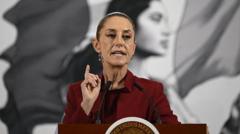President Sheinbaum has expressed her government's belief that the name change violates the country's sovereignty, highlighting the US's overreach in renaming a shared geographic feature. Initially, Sheinbaum solicited Google to amend the naming designation in January, followed by a formal threat of legal action a month later. As stated by Google, the adjustment aligns with its policy to adopt changes that emerge from official government updates. However, the gulf remains labeled as the Gulf of Mexico for users in Mexico, while those in other regions will see both names appear.
Tensions escalated around the issue, especially as the US House of Representatives voted to officially recognize the Gulf of America for federal use. Former President Donald Trump set the tone for the name change with an executive order during his initial days in office, claiming the gulf predominantly belongs to the US.
In a broader context, this dispute has drawn parallels to other geopolitical naming conventions, with Trump hinting at potential changes in the US's references to the Persian Gulf during his upcoming visit to Saudi Arabia. The Iranian government has already expressed its opposition to such proposed changes, emphasizing the complexity and sensitivity surrounding geographical names.
As the conflict unfolds, the impact on international relations and the significance of territorial naming continue to resonate within diplomatic circles.
Tensions escalated around the issue, especially as the US House of Representatives voted to officially recognize the Gulf of America for federal use. Former President Donald Trump set the tone for the name change with an executive order during his initial days in office, claiming the gulf predominantly belongs to the US.
In a broader context, this dispute has drawn parallels to other geopolitical naming conventions, with Trump hinting at potential changes in the US's references to the Persian Gulf during his upcoming visit to Saudi Arabia. The Iranian government has already expressed its opposition to such proposed changes, emphasizing the complexity and sensitivity surrounding geographical names.
As the conflict unfolds, the impact on international relations and the significance of territorial naming continue to resonate within diplomatic circles.





















